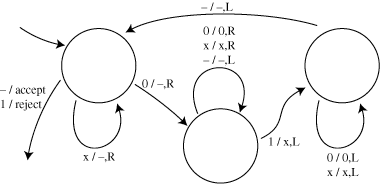
The circles in the following diagram represent the states of a Turing machine. An arrow labeled "a/b,D" means that if the machine sees the character "a", it replaces it by "b", moves in direction D (either left or right), and changes state as indicated by the arrow. An arrow labeled by "a/accept" or "a/reject" means the machine halts and accepts or rejects the string as indicated. The unlabeled arrow indicates the start state. A dash indicates the blank character.

Note: there was a mistake in the Turing machine; the
top arrow is supposed to be labeled "-/-,R" rather than "-/-,L".
Other than this mistake, the machine is essentially the same as one for
recognizing strings of balanced parentheses (but with the character zero
instead of left parentheses and the character one instead of right
parentheses). But because
of this mistake, the problem was easier than it should have been.
The answers for the machine given are that it rejects 10 and accepts all
the other strings.
The answers for the machine I intended to write are that it accepts 01
and 0011, rejects 10 and 011, and goes into a loop for 001.
(Hint: repeatedly pass left-to-right across the string to test whether there is exactly one "1" left, and right-to-left across the string changing every other "1" into a "0").

Answer: because Church's thesis (namely, the idea that any computer we can actually build can be simulated by a Turing machine) is partially about the real world, and is therefore a statement of physics rather than purely mathematical. Physical theories can be disproven by experiments but can never be proven mathematically.